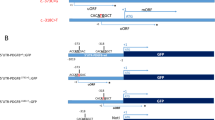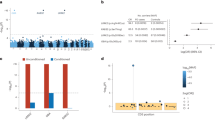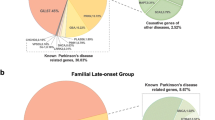Abstract
Four causative genes, including solute carrier family 20 member 2 (SLC20A2), platelet-derived growth factor receptor b (PDGFRB), platelet-derived growth factor b (PDGFB)and xenotropic and polytropic retrovirus receptor 1 (XPR1), have been identified to cause primary familial brain calcification (PFBC). However, PDGFRB mutations seem to be quite rare and no PDGFRB mutations have been reported in Chinese PFBC patients. A total of 146 PFBC patients including 12 families and 134 sporadic patients were recruited in this study. All of them were previously tested negative for the SLC20A2. Mutational analyses of the entire exons and exon–intron boundaries of PDGFRB were carried out by direct gene sequencing. In silico analyses of the identified variants were conducted using Mutation Taster, PolyPhen-2 and Sorts Intolerant From Tolerant. Two heterozygous variants, c.3G>A and c.2209G>A, of the PDGFRB gene were revealed in two PFBC families, respectively. These two variants were not observed in 200 healthy controls. The variant c.3G>A was located in exon 2 and affected the initiation codon of the PDGFRB gene. The variant c.2209G>A resulted in amino-acid substitutions of aspartic acid to asparagine at position 737. Both of these two variants co-segregated with the disease phenotype (variant carriers in Family 1: I1, II2 and II3; variant carriers in Family 2: I2 and II8), suggesting a pathogenic impact of these variants. The prevalence of PDGFRB mutations in Chinese PFBC patients seems to be quite low, indicating that PDGFRB is not a major causative gene of PFBC in Chinese population.
Similar content being viewed by others
Log in or create a free account to read this content
Gain free access to this article, as well as selected content from this journal and more on nature.com
or
References
Sobrido, M. J., Coppola, G., Oliveira, J., Hopfer, S. & Geschwind, D. H. in GeneReviews(R) (eds Pagon, R. A., Adam, M. P., Ardinger, H. H., Wallace, S. E., Amemiya, A., Bean, L. J. H. et al.) (Seattle, WA, USA, (1993).
Oliveira, J. R., Spiteri, E., Sobrido, M. J., Hopfer, S., Klepper, J., Voit, T. et al. Genetic heterogeneity in familial idiopathic basal ganglia calcification (Fahr disease). Neurology 63, 2165–2167 (2004).
Nicolas, G., Pottier, C., Maltete, D., Coutant, S., Rovelet-Lecrux, A., Legallic, S. et al. Mutation of the PDGFRB gene as a cause of idiopathic basal ganglia calcification. Neurology 80, 181–187 (2013).
Wang, C., Li, Y., Shi, L., Ren, J., Patti, M., Wang, T. et al. Mutations in SLC20A2 link familial idiopathic basal ganglia calcification with phosphate homeostasis. Nat. Genet. 44, 254–256 (2012).
Keller, A., Westenberger, A., Sobrido, M. J., Garcia-Murias, M., Domingo, A., Sears, R. L. et al. Mutations in the gene encoding PDGF-B cause brain calcifications in humans and mice. Nat. Genet. 45, 1077–1082 (2013).
Legati, A., Giovannini, D., Nicolas, G., Lopez-Sanchez, U., Quintans, B., Oliveira, J. R. et al. Mutations in XPR1 cause primary familial brain calcification associated with altered phosphate export. Nat. Genet. 47, 579–581 (2015).
Lemos, R. R., Ramos, E. M., Legati, A., Nicolas, G., Jenkinson, E. M., Livingston, J. H. et al. Update and mutational analysis of SLC20A2: a major cause of primary familial brain calcification. Hum. Mutat. 36, 489–495 (2015).
Nicolas, G., Pottier, C., Charbonnier, C., Guyant-Marechal, L., Le Ber, I., Pariente, J. et al. Phenotypic spectrum of probable and genetically-confirmed idiopathic basal ganglia calcification. Brain 136, 3395–3407 (2013).
Sanchez-Contreras, M., Baker, M. C., Finch, N. A., Nicholson, A., Wojtas, A., Wszolek, Z. K. et al. Genetic screening and functional characterization of PDGFRB mutations associated with basal ganglia calcification of unknown etiology. Hum. Mutat. 35, 964–971 (2014).
Richards, S., Aziz, N., Bale, S., Bick, D., Das, S., Gastier-Foster, J. et al. Standards and guidelines for the interpretation of sequence variants: a joint consensus recommendation of the American College of Medical Genetics and Genomics and the Association for Molecular Pathology. Genet. Med. 17, 405–424 (2015).
Andrae, J., Gallini, R. & Betsholtz, C. Role of platelet-derived growth factors in physiology and medicine. Genes Dev. 22, 1276–1312 (2008).
Tallquist, M. D., Klinghoffer, R. A., Heuchel, R., Mueting-Nelsen, P. F., Corrin, P. D., Heldin, C. H. et al. Retention of PDGFR-beta function in mice in the absence of phosphatidylinositol 3'-kinase and phospholipase Cgamma signaling pathways. Genes Dev. 14, 3179–3190 (2000).
Vanlandewijck, M., Lebouvier, T., Andaloussi Mäe, M., Nahar, K., Hornemann, S., Kenkel, D. et al. Functional characterization of germline mutations in PDGFB and PDGFRB in primary familial brain calcification. PLoS ONE 10, e0143407 (2015).
Arts, F. A., Velghe, A. I., Stevens, M., Renauld, J. C., Essaghir, A. & Demoulin, J. B. Idiopathic basal ganglia calcification-associated PDGFRB mutations impair the receptor signalling. J. Cell Mol. Med. 19, 239–248 (2015).
Nicolas, G., Charbonnier, C., de Lemos, R. R., Richard, A. C., Guillin, O., Wallon, D. et al. Brain calcification process and phenotypes according to age and sex: Lessons from SLC20A2, PDGFB, and PDGFRB mutation carriers. Am. J. Med. Genet. B Neuropsychiatr. Genet. 168, 586–594 (2015).
Wider, C., Dickson, D. W., Schweitzer, K. J., Broderick, D. F. & Wszolek, Z. K. Familial idiopathic basal ganglia calcification: a challenging clinical-pathological correlation. J. Neurol. 256, 839–842 (2009).
Tadic, V., Westenberger, A., Domingo, A., Alvarez-Fischer, D., Klein, C. & Kasten, M. Primary familial brain calcification with known gene mutations: a systematic review and challenges of phenotypic characterization. JAMA Neurol. 72, 460–467 (2015).
Acknowledgements
We sincerely thank the patients and their relatives for participation. This work was supported by the grant nos 81322017, 81371261 and U1505222 from the National Natural Science Foundation of China and grant NCET-13-0736 from the Program for New Century Excellent Talents in University, National Key Clinical Specialty Discipline Construction Program and Key Clinical Specialty Discipline Construction Program of Fujian.
Author information
Authors and Affiliations
Corresponding author
Ethics declarations
Competing interests
The authors declare no conflict of interest.
Rights and permissions
About this article
Cite this article
Wang, C., Yao, XP., Chen, HT. et al. Novel mutations of PDGFRB cause primary familial brain calcification in Chinese families. J Hum Genet 62, 697–701 (2017). https://doi.org/10.1038/jhg.2017.25
Received:
Revised:
Accepted:
Published:
Issue date:
DOI: https://doi.org/10.1038/jhg.2017.25
This article is cited by
-
PDGF receptor mutations in human diseases
Cellular and Molecular Life Sciences (2021)
-
A novel PDGFRB sequence variant in a family with a mild form of primary familial brain calcification: a case report and a review of the literature
BMC Neurology (2019)
-
Basal ganglia calcifications (Fahr’s syndrome): related conditions and clinical features
Neurological Sciences (2019)
-
Primary brain calcification: an international study reporting novel variants and associated phenotypes
European Journal of Human Genetics (2018)
-
Clinical and radiological diversity in genetically confirmed primary familial brain calcification
Scientific Reports (2017)



